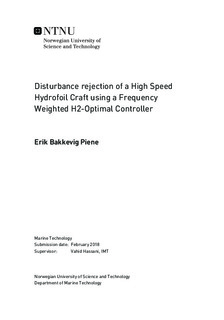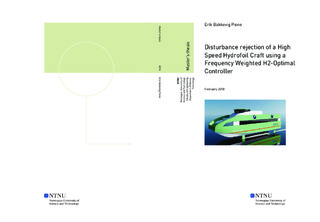| dc.description.abstract | The study presented in this report look into the design of a Ride Control System reducing wave-induced motions in heave, roll and pitch on a fully submerged hydrofoil craft sailing in 17 m/s. A frequency weighted, multiple-input multiple-output H2-optimized feedback controller is used.
The craft is modelled in 6 Degrees of Freedom with nonlinear models for rigid-body dynamics and foil forces. Four identical and symmetrically located foils are carrying the weight of the craft, and four identical and symmetrically located rudders are controlling motions in yaw. The only external forces and moments acting on the craft-body are gravity, lift and drag forces from the foils and rudders, and a thrust force in surge keeping the speed constant. No air or other water resistance is modelled.
The wave disturbances are implemented by letting the orbital motions of water particles change the magnitude and direction of the relative inflow velocity on the foils. These orbital motions are calculated from a linear model of one or more regular wave components. The craft model has four generalized control inputs, where three of them are controlling heave, roll and pitch by adjusting the angles of the lifting foils differently, and the fourth is controlling yaw by adjusting the rudder angles.
The simulation model of the craft is then linearized with respect to motions in heave, roll and pitch. The linearization is done about a trim condition with zero angles in roll and pitch, a constant position in heave, and zero velocity in all degrees of freedom, except for the constant speed in surge. Only control inputs for heave, roll and pitch are included. The linearized model is expressed as a nine-dimensional state-space model, where first three states are generalized actuator dynamics, and the last six are position and velocity in heave, roll and pitch.
The linearized model is then augmented with first-order frequency-weighting functions, in order to generate performance signals with frequency-dependent sensitivity to state errors and control inputs. The higher value of the performance signal, the higher penalty on the corresponding state error or control input. The state errors are given penalty at low frequencies, and the control inputs are given penalty at high frequencies. Additional frequency-weighting functions are used in order to transform white-noise signals into expected, colored wave disturbances. These white noise-signals, together with white sensor noise and reference state values, constitute the external inputs in the augmented model.
The H2-optimized controller is minimizing the 2-norm of the closed-loop transfer matrix from external inputs to the performance signals. It is computed from the augmented model by using the h2syn() function in the Robust Control Toolbox in MATLAB.
The yaw rate and surge speed of the craft is controlled by separate, external proportional-integral-derivative controllers, and the speed in sway is controlled to zero with an external proportional-integral controller updating the reference for the roll angle.
Simulink is used to simulate the system of the controlled craft in three different sea conditions: Regular long-crested waves, irregular long-crested waves, and irregular short-crested waves.
For each sea condition, straight-line motion in both following and head sea is simulated. A coordinated turn is also simulated in irregular, short-crested waves. In total seven different cases are simulated. Sensor noise is added to the signals entering the H2 controller, but not the external controllers.
Simulation results shows that the Ride Control System in all of the cases is able to control the attitude of the craft, as well as reducing the wave-induced disturbances. Performance is better in regular than in irregular waves, better in short-crested than in long-crested irregular waves, and better in following sea than in head sea. The last is due to the choice of frequency-weighting functions for the error performance signals, since they are giving less penalty on errors caused by higher encounter frequencies. The results do also show large pitch accelerations in the case of head sea with long-crested, irregular waves. The choice of weighting functions is a trade-off between good performance, and minimization of sensor noise penetrating the controller and causing high-frequency vibrations in the actuators. Higher order weighting functions or a more accurate linearized model can reduce the problem. | |

